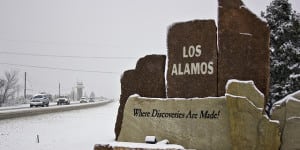
The Los Alamos National Laboratory in New Mexico is taking steps to address a recent series of errors in waste handling that earned it a state penalty, and to keep them from recurring, a spokesman said Wednesday.
Among other measures, LANL voluntarily suspended all waste shipments from Dec. 18 through Feb. 28, while it investigated how it mislabeled a container of hazardous waste sent to contractor Veolia in Colorado for disposal. The container included “chemical solvents and things of that nature,” according to lab spokesman Peter Hyde. A second mislabeled container was discovered before it was sent to Veolia, the spokesman said.
But because LANL was not shipping waste off-site, five containers of mixed-low-level radioactive waste and hazardous waste were kept too long in temporary storage areas, Hyde acknowledged. As a result, the New Mexico Environment Department (NMED) plans to penalize LANL for keeping three containers in a central storage area beyond the allowed 90-day limit. The lab also will be cited for leaving the two other containers in an area beyond the allowed one-year limit.
All five containers have now been moved into “safe, compliant storage” or been shipped off-site, Hyde said.
NMED’s Hazardous Waste Bureau could fine LANL and site contractor Los Alamos National Security (LANS) $10,000 daily for each instance of noncompliance. The state agency said in a March 15 letter two containers had already stayed 20 days beyond the 90-day limit before LANL requested an extension. In its letter, NMED said it has additional enforcement options, including a civil action in court against the DOE nuclear-weapon laboratory seeking to suspend the LANL hazardous-waste permit.
The New Mexico Environment Department enforces the state’s hazardous waste management regulations, as well as compliance with the federal Resource Conservation and Recovery Act. The state will spell out exact penalties in a forthcoming letter to LANL. Terms of the penalty will eventually be made public.
“LANL’s past history of noncompliance” will factor into the final penalty, according to NMED. In February 2014, a drum of transuranic waste from the site, which was incorrectly packed with organic kitty litter, ruptured underground in DOE’s Waste Isolation Pilot Plant near Carlsbad. WIPP was out of operation for nearly three years, and the state and federal governments eventually reached a $73 million legal settlement over various violations at the two DOE sites.
The WIPP incident contributed to Los Alamos National Security’s loss of both its cleanup and management contracts for the lab.
The current situation stems from transposed numbers being placed on two containers in November, which resulted in the mislabeled containers, the spokesman said. Although LANL knew holding up shipments would result in storage citations from the state, it wanted to be “confident that we had fully addressed the issue” of mislabeling, Hyde added.
“We are working closely with the state to evaluate our processes and procedures to make sure that our shipping program is in compliance with all regulations,” Hyde said.
In a separate instance, LANL acknowledged it misplaced 2 gallons of chemical solvents between Feb. 1 and Feb. 5. It was ultimately discovered the solvents had been placed in the wrong container, Hyde said. To avoid a repeat, LANL will ramp up from monthly to weekly inventory reviews of its waste, he added: “We take these situations very seriously.”
NMED said this week it continues to monitor compliance issues at the lab.
One local watchdog was skeptical of the lab’s efforts. “It’s paperwork that needs to get done correctly and isn’t,” Scott Kovac, operations and research director of Nuclear Watch New Mexico, said via email. “Lord knows they have enough people and budget to do the job correctly.”
The problems at LANL predate the 12-year tenure of Los Alamos National Security (LANS), which is being replaced as the site’s legacy waste contractor at the end of this month, Kovac said. The Energy Department is also expected by May to issue a new 10-year management and operations contract for the lab.
“I think it’s an oversight problem. LANL culture wants to re-invent everything while rebelling against authority,” Kovac said. “These are the mistakes that we know about because the NMED is on the job overseeing the hazardous and mixed waste,” he added.
State Cited LANL for Permit Violations in November
An NMED inspection in November also found LANL was in violation of several conditions of its state hazardous waste permit.
In a March 13 letter, NMED said vanadium oxide, “an acutely toxic hazardous waste,” was found inside a cardboard box marked as a nonhazardous waste. The lab also failed to segregate “incompatible” hazardous wastes: Two 5-gallon containers of a liquid oxidizer were stacked atop a 5-gallon container of “flammable solids,” according to the letter.
Other violations included an instance of wastes being stored on a flammable cabinet; a failure to label certain containers as hazardous waste, and failure to respond to an oil leak from mixing equipment, NMED said in the document.
The waste violations had all been sufficiently addressed by Feb. 16, according to the state. “Please be aware that any future substantial deviations from regulatory requirements may result in your facility being considered for an elevated enforcement action,” NMED said in the March 13 letter.
“Overall, this year’s annual RCRA inspection by the State shows improvement in our performance from past years, as evidenced by fewer non-compliances,” a LANL spokesperson said by email Thursday. (The spokesperson did not say how many infractions had been cited in prior inspections). “That said, we continue to strive for the best possible compliance record particularly when it comes to protecting the environment, the public and our workforce.”